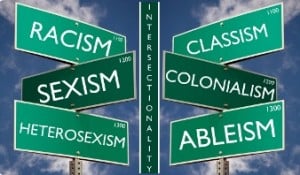
Source: Genderfork
Originally published on Media Diversified and republished here with their permission.
I’ve heard it said that lesbian femme women come out every day. This is in reference to them having to constantly inform people that they are in fact lesbians.
“But you don’t look gay” is a common response. And this is the point at which the woman in question might roll her eyes and say or think, “And what the hell does gay look like?”
In my experience, Masculine of Center (MoC) women have their own version of coming out every day, particularly at work. Such was the case when I started working for a company that I will call Gender Trouble, Inc.
Think of GT Inc as your run-of the-mill corporate office.
It’s a large corporation with many different people, from all walks of life. Despite this organizational diversity, I don’t think they ever foresaw a person like me coming in and subverting some of their most taken-for-granted assumptions about how gender and sexuality should be represented in the workplace.
Now a little about me.
When you catch me on an ordinary day in the street, I’m pretty unassuming. I will probably have on some jeans, a tee, and sneakers – nothing that gender defining (well depending on how I’m wearing my clothes).
In most places that I have worked at, they have had a casual dress code. So I could get away with some simple Dockers and a polo shirt. No fuss.
On the day that I walked into GT Inc and was told that they had an “All business, all the time” dress code, I must admit that I panicked.
Any doubt about the extents of their ideas about gender binaries were eliminated by the dress code worksheet in the New Employee handbook, complete with a little cartoon male in his standard slacks, button down shirt, and necktie, directly opposite a little woman in a dress (with the exact appropriate length marked in inches) and heels.
It should have been relatively simple for me. I have never had a problem in being a very out individual. If within about five minutes of meeting me you don’t know that I am gay, then maybe I haven’t actually spoken yet.
But it felt like this was going to be a defining moment in my journey as a Masculine of Center woman. I had to make a decision as to what type of gender representation I was going to take on or “perform,” as the queer theorist Judith Butler has described it.
For Butler, gender identity, along with other identities, is a form of dress or drag. It is something that we all have to continually bring into being through what we do on a daily basis.
As Ru Paul has put it, “We were born naked. Everything else is drag.”
The situation at GT Inc brought these implicit ideas about how gender should be performed into the open.
I was faced with a decision: Should I put my gender identity in the closet and become a corporate drag act, opting for the apparently safe road of playing femme at work?
The issue of gender discrimination in the workplace based on dress is one that has been brought before the courts several times.
In 1989, Ann Hopkins won a Supreme Court decision against the accountants Price-Waterhouse for sex discrimination.
Among other things, the case included the allegation that Hopkins was told that in order to get promotion she should, “walk more femininely, talk more femininely, dress more femininely, wear makeup, have her hair styled, and wear jewelry.”
Although Hopkins won her case, the idea that there should remain separate standards for dress for men and women was unchallenged.
My personal approach to dress at GT Inc was to stick strictly to the “male” dress code, making sure to stay with traditional slacks, button down dress shirts, and ties.
So what I was wearing were acceptable business garments, but not “female” business dress. So what of the gender non-conforming individual who does not want to pass as femme?
Who simply wants to go to work as comfortable as they can, without suffering the trauma of being pushed back into the closet for a paycheck?
My decision to not comply with the gendered codes at GT Inc was a defining moment for all involved. When I raised my hand to clarify the company rule – “So anytime we wear a dress shirt, we must wear a tie as well, right?” – the room went silent, and my trainer stared at me for a good three minutes and finally answered hesitantly, “Yes, the men do, yes.”
I decided to ignore the “men do” part. Clearly, my trainer did not have any experience with these types of questions or situations. This is symptomatic of the lack of dialogue on the subject.
As with most cases of discrimination in the US, without a federal case, there is usually little conversation or awareness. This lack of discourse can leave things open to the discretion of the workplace, but it does not serve the LGBTQIA+ communities at large at all.
It can leave gender non-conforming or trans individuals with more questions than answers. For people who regularly face trauma inflicted by the fear, anxiety, and hatred of others, we may not feel safe walking into a workplace in our chosen attire as we have no legal protection.
As fate would have it, my first week on the call center floor fell on a weekend, which is a casual dress period. I made friends as soon as I hit the floor because c’mon, who doesn’t love me?!
The very next day I came in and did all the dapper bois proud. Black slacks, white dress shirt with a pink/black/white silk tie. Hair freshly twisted up with my shades on. And yes, I turned many heads.
I walked in and saw all the women in the office look over to watch me walk down the aisle. I got to my group and nobody said a word. And then finally one of the women supervisors said, “Ooh, I like your tie.” And so my journey as the first boi in began.
You never really forget the day you realize that not only are you a stranger in a foreign land, but you are the first of a species that those around you have ever encountered.
I had to get used to the daily stares, the interested glances of some, and the disdain of others. I had to tow the fine line between curious women and distrustful men.
And I had to do this while all the time trying to maintain a sense of who I was, while also making sure to carry myself in such a way as not to fall prey to any preconceived notions that people might have because of what I wore.
As a woman of color, I also had to contend with the ways in which dominant versions of masculinity intersect with race and class.
Some people thought that because I wore a tie and had a “masculine” demeanor that I was going to be hyper-aggressive and that they would not be able to communicate with me.
For many people, the only time they “see” a butch women, especially a black butch women, she is usually working-class, wearing jeans with a white t-shirt, and a backwards-facing cap. Media representations of Queer People of Color can be especially limited and pathologizing.
To borrow a term from the black feminist psychologist Ann Phoenix, and to apply it to the media, the depiction of queer people is often marked by a “normalized absence/pathologized presence” duality.
When we are not invisible, we are the black butch woman that the world sees selling drugs on the street, being violent, or some other form of negative representation. It is rare that we are allowed to be seen as full human beings.
This is a point that Janet Mock has made when talking about how she wanted her book Redefining Realness to intervene in the genre of trans memoirs:
“Transition or trans memoirs have been very much an apolitical space. It’s also been an older space.
“And so, I wanted to throw in the intersection of youth and also race and class, and have those discussions and also make a place for the erotic within this text too, like, ‘What do we do with our bodies?’
“Because that’s also important, that we’re fully livable, loving beings, sensual, and pained and traumatic and all of that stuff.”
So on that day when I walked into the workplace “all business,” I exuded a kind of confidence that was unusual for those observing me.
I was told that I walked in every day like I owned the place and that people were thrown by me because not only did I dress like the guys, but I out-dressed the guys. And all I was doing was being me.
It has been interesting to watch the change in attitudes since I have been with the company. I understand that part of it is personal: me being me in all my complexity – being confident, talkative, charismatic, sometimes playing a fool.
I have seen people whose attitudes have changed towards me and in sense towards MoC women more generally. There are girls who love to talk to me, and yes, love to flirt with me. There are men who have tried to make me the unwilling boi in their boys club.
But I don’t want to suggest that challenging gender discrimination is all about the individual. We are always struggling with the weight of bigger social forces and sometimes it makes little difference how confident or “likeable” we may be as individuals.
People can coopt individuals that they know as friends and remain just as racist/sexist/homophobic/classist/ableist to others.
There are people who I work with who can’t get used to having a person like me around. Some women are too scared to talk to me and make sure to draw attention to any woman that I talk to more than twice. Yes, I notice.
And sometimes, I wonder if one day my story will be told as a part of a larger conversation about gender dress codes or whether the questions that I raise by my presence will simply disappear when I no longer work for the organization.
Will it really be that much easier for the next MoC woman that walks through those doors? I have no idea. But I’m certain I will never forget my experience as the first boi in.
[do_widget id=”text-101″]
Carolyn Wysinger is a thirty something masculine of center womyn from Richmond, Ca. She is a writer & Social Entrepreneur. She has served on the steering committees for BUTCHVoices and Black Lesbians United. She is a board member of the NIA Collective for same-gender loving women of African Descent. Her first book “Knockturnal Emissions: Thoughts on #race #sexuality #gender & #community” is currently available on Glover Lane Press. Follow her on Twitter @knockturnalpro and on Instagram at theknockturnalproject.
This article was edited by Yasmin Gunaratnam.
Search our 3000+ articles!
Read our articles about:
Our online racial justice training
Used by hundreds of universities, non-profits, and businesses.
Click to learn more




















